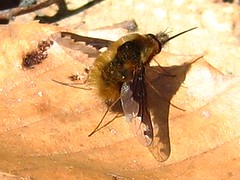Janneke was the first to notice the elusive Bee Fly in its native habitat, in this case, the St. John's conservation area in the Short Hills.
Up 'till my 36th year of life, I had not known about the existence of the Bee fly. Now that I do I'm intent on getting good photographs of this springtime oddity.
The Bee Fly, as an adult, drinks nectar from flowers and looks and sounds much like a bee. As a larva, however, the bee fly devours the young of the solitary bee. In order to accomplish this, the Bee Fly emerges early to be ahead the solitary bee's life cycle. The Bee Fly seems to need to stay warm and so is often seen resting on light-coloured objects such as faded leaves or pale coloured walls. This makes it tricky to get a good photograph of, as the background tends to come out too bright and the fly too dark.
Other warmth-maximizing features in this fly include its fuzz, the dar colouration on its body, and the dark colouration on its wings.
